Morocco
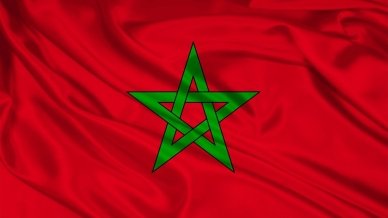
This North African kingdom is bounded by the Atlantic Ocean and the Mediterranean Sea, and only the Strait of Gibraltar separates it from Europe. The Americans and Europeans call it Morocco, the Arabs have given it the name of al-Maghrib, and the Berber tribes made it known as Amur n’wakuc (Holy Land).
Here, vegetarianism is considered an unforgivable sin, but even vegetarian food is not enough for all people because almost 25% of local residents are unemployed. Nonetheless, Morocco is one of the five largest economies of the African continent. Most of the national budget is generated by the influx of foreign tourists (10 million people per year).
Travellers are lured by the spirit of exciting and bright Arab fairy tales and a fascinating symbiosis of patriarchy and modern trends.

General Information
Spending a holiday in Morocco will leave myriads of overriding impressions that may emerge at every turn. This country is a home for three cultures at once. The Arab, Berber, and European ways of life have coexisted harmoniously and have had a peculiar impact on the Moroccan mentality, customs, and lifestyle.
Historical Background
Morocco dates back to ancient times: the first humans appeared there around 400,000 years ago. Even Egypt, which has a 50,000-year history, is too young in comparison with al-Maghrib.
At the very beginning, those lands belonged to Carthage — the Phoenician state that had a continuous impact on the entire Mediterranean coast.
However, the Roman Empire took the initiative. The Punic Wars began, as a result of which the Romans won a victory. The phrase of one of the Roman senators, “Ceterum censeo Carthaginem esse delendam” (“Furthermore, I consider that Carthage must be destroyed”), sounded like a verdict for a once-prosperous state. The city was reduced to dust, and the dwellers were killed and enslaved.
Anyway, the Romans did not reign over the conquered territory. Initially, there came the Vandal tribes, and later — the Byzantines. At the end of the 7th century, the Arabs got control of the lands of future Morocco.
The Arab monarch dynasties successfully built their enormous empire in North Africa and the Pyrenees for 800 years. Their influence extended to modern Lybia, Algeria, Tunisia, and partly Spain and Portugal.
The domination of the Arabs ended in the 15th century. Spanish and Portuguese monarchies got stronger and decided to even the score, having expanded within North African lands. That was a very appropriate moment as the Almohad Caliphate was on the decline.
The Spanish and Portuguese took control of Morocco for the following 150 years. However, in 1578, the Battle of Three Kings, fatal for Portugal, took place and ended the reign of Lisbon over the Moroccan land and its independence as it was.
Morocco began flourishing again, and those times continued till the beginning of the 17th century. Moroccan sultans enforced their rule over the African north, extending its borders considerably.
Gradually, the might of the sultanate faded owing to never-ending court intrigues and rivalry for the throne. In essence, sea pirates got into power and, in many cities, have taken the role of proxy rulers.
In the second half of the 19th century, the Spanish put forward the claims for the Moroccan territories. Though Spain won a victory in the war, the success was only partial.
The beginning of the 20th century was a turbulent time for Morocco. Apart from Spain, its territories were also invaded by Britain, France, and Germany. The French were the luckiest. They had settled in the west of Africa and thus were willing to expand their territories at the expense of new lands in the North African region.
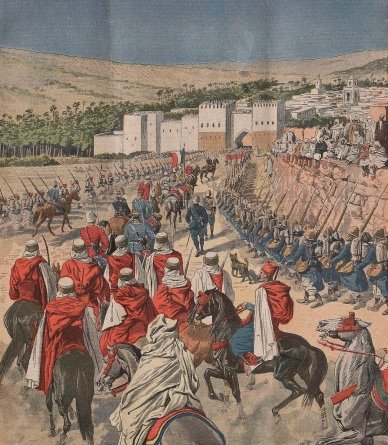
“In Morocco, the column of General Baumgarten occupies Taza”, Le Petit Journal, May 1914
Despite the initial opposition to Germany, France managed to settle in Morocco for the following 50 years, establishing a considerable part of the African country as its protectorate.
Being a colony meant that Morrocans were subject to violent Frenchification. Even nowadays, French is the second most spoken language after Arabic. Moreover, the military forces of France recruited young and healthy Moroccans to fight in World War I. More than a million Morrocan soldiers died in the battles.

Generalissimo Joseph Joffre with soldiers of the Moroccan Division in 1915
In 1956, Morocco became liberated again: its French part gained independence in spring. As time passed, the second half that belonged to Spain also got its sovereignty.
A re-united and absolutely independent country became a member state of all international organisations, like the UN, the Arab League, WHO, and others. However, it resigned the membership of some of them due to political concerns.
Nowadays, Morocco is one of the most developed African countries. But considering the overall poverty of the continent, such welfare is highly relative.
Geography and Climate
In Africa, Morocco borders Algeria and Western Sahara. However, the Moroccan government strenuously refuses to recognize the latter, considering Western Sahara a part of the country’s territory. According to their version, the southern boundaries stretch across Mauritania. There is also the borderline with Spain located through Gibraltar.
The coast of Morocco is surrounded by the Atlantic Ocean and the Mediterranean Sea, which can be considered a stroke of enormous geographic luck for the north of Africa. The other countries of this region are either bordered only by the seas (Egypt) or do not have any marine success at all (Algeria).
The Mediterranean coast is not as popular among tourists as the Atlantic is. And almost all top Moroccan resorts are located in Agadir, Oualidia, and Asilah.
Moroccan climate is not homogenous and varies by locality. The Atlantic and Mediterranean coasts are well-known for benign atmospheric conditions with hot and dry summer and mild winter.
The Atlas Mountains are covered with snow. And there is so much of it that the Moroccan mountain ski resorts are strong competitors of the Austrian, Slovakian, and other European pistes.
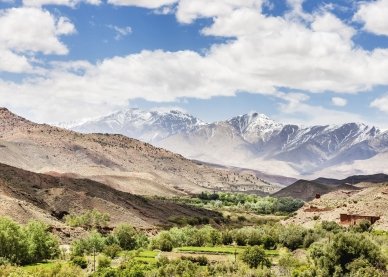
The Atlas Mountains
The high season in Morocco lasts seven months. It begins in April and ends late in October, but August is usually the hottest time. The air temperature reaches +36°C - +40°C, and the water warms up to +22°C. Besides, the Atlantic waters are always cool regardless of the heat. The best spots for beach recreation are legendary Casablanca, Marakkesh, Agadir, and Essaouira.
The silent period begins in November when daily temperatures drop to +12°C - +15°C; it also rains very often. During this season, the costs of package tours to Morocco fall considerably for some time. But when Christmas days come, the prices rise again. Thousands of thrill-seekers hurry to Oukaimeden and Ifrane — the leading mountain ski centres of the country.
Autumn and spring in Morocco are mild, and temperatures are comfortable to have a good rest. It is a perfect vacation for those indifferent to hot beaches and pistes but ready to wander around and explore the attractions for hours.
Spring is also the time when trees begin to bloom. Moroccan cities delve into the astonishing whirl of heady aromas. Round-the-clock aromatherapy sessions are a luxurious nature’s gift to Moroccans and the visitors to their magnificent homeland.
Population, Language, and Currency
Morocco is a big Arabic-speaking country with a population of 38 million people. Their ethnic composition comprises 60% of the Arabs and less than 40% of the Berbers who adhere to Sunni Islam.
Arabic and Berber are the official languages. Interestingly, the Morrocan dialect is strikingly different from the standard rules and principles, and thus it is hardly understood in the Arab world.
No less compelling is the situation with the Berber language. Earlier, it was just conversational, but lately, its writing system has become widely studied at schools based on the only remaining alphabet called Tifinagh.
Moroccan capital, Rabat, is not the most populated city; there live only 500,000 people. Casablanca, so much adored by Hollywood directors, is the biggest metropolis in Morocco (3.5 million residents). There unfolded the events of several American movies (for example, Mission: Impossible – Rogue Nation, the fifth part of the world-known blockbuster).

Moroccan capital, Rabat
The other big and immensely visited cities are as follows:
- Fez (1.2 million people) and the world’s oldest operating University of al-Qarawiyyin, opened in the 9th century;
- Marrakesh (1 million people), the old part of which, medina, is a UNESCO world heritage site;
- Meknes (550,000 people), also included in the list of UNESCO world heritage sites due to the vast number of sightseeing attractions.
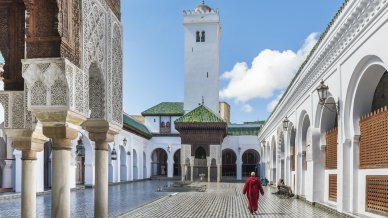
The world's oldest operating university, Al-Qarawiyyin University in Fez, Morocco
Rabat, Fez, Marrakesh, and Meknes are the four imperial cities of Morocco because, at different times, they were the capitals of this country.
The official currency is the Moroccan dirham, the value of which against the US dollar is considered one of the stablest in the world. The MAD - USD exchange rate is 1:0.11.
Directions
Undoubtedly, the best way of getting to Morocco is to fly. There are flights from Europe, the Americas, Australia, New Zealand, and Asia. Tourists may opt for a variety of airlines, like British Airways, EasyJet, Ryanair, Air France, Lufthansa, Etihad, Air New Zealand, etc.
Fares may be rather high during the Christmas period or high season, but if to book or even buy two months in advance, you may be lucky enough to find low-cost tickets. Besides, airlines often offer various discounts dedicated to some landmark events. But one should constantly monitor the prices to catch the best offers.
As a rule, flights take seven hours or longer without the transit time.
Royal Air Maroc is the country's largest air carrier that serves 99 destinations to different parts of the world.
Some tourists travel by ferry or car, but this journey takes a few days and is really exhausting.

Accommodation
When you travel to Morocco on your own, it means that you will need to plan the trip by yourself, considering all the day-to-day realities of this unique country.
The most evident accommodation option is to book a hotel room that costs almost the same money as in European hotels ($40 - $50). However, the conditions often may not correspond to the claimed star rating, and thus tourists complain about the rooms not being clean enough.
In addition, one will need to bear in mind a specific attitude of Moroccans towards tourists coming from other countries. For some reason, they perceive them as millionaires, and in this way, the latter undergo some pressure of hard sell. Locals literally demand money for everything they offer.
In this way, below are several budget-friendly hotels in Morocco to accommodate during a holiday:
- DAR IMPERIAL is a two-star pet-friendly hotel in Aroumd that offers cosy and renovated rooms with air-conditioning, free Wi-Fi, and breakfast. The guests are welcomed by excellent staff.
- Résidence Intouriste is a three-star hotel in Agadir, located a 200-m distance from the beach. The rooms are equipped with air-conditioning, TV sets, and other facilities, like bathrooms, etc.
- Meriem is a four-star hotel in Marrakesh, well-known for rooms with air-conditioning, balconies, and free Wi-Fi. There is also a swimming pool.
- Ibis El Jadida is a three-star hotel in Casablanca. The rooms have all the necessary facilities, free Wi-Fi, breakfast, and a car park.
- Tentes Nomadic is a four-star hotel in Tinfou that will be perfect for those willing to familiarize themselves with the life of Bedouins. It is located in the desert and comprises separate plainly-furnished tent houses.
Experienced tourists, who have come to Morocco many times, stay at hotels very rarely. Instead, they prefer riads, the authentic Moroccan-style houses available for rent in the cities’ cultural centres called medinas.
A typical riad is a courtyard with an interior garden. The rooms are located around the yard or patio periphery; usually, there is a fountain or a tropical plant in the centre.
It is a beautiful accommodation that offers all the necessary facilities. You will be enchanted by bright and lush colours, oriental-style furniture like sofas with many cushions, carpets, and small tables.
Though a riad room costs the same money as the one in a hotel, facilities and comfort are much better. You may rent the riad in Morocco through such online platforms as booking.com, Airbnb, etc.
Places to See
A bizarre plethora of ancient monuments, Arab fortresses, and European quarters that date back to the colonization era have naturally interlaced with present-day realities, like high-speed railway lines, skyscrapers under construction, and the flows of cars.
That is a modern country, dynamically changing and treasuring the memory of its history. In Morocco, they do not hurry to knock down the old things while building the new ones. And Moroccan architects are good at combining contemporary trends and ancient traditions.
Tangier
It takes only 14 km across Gibraltar to get here from Spain. And you will end up in Tangier, one of the biggest Moroccan cities, which is often called Moroccan Riviera due to a striking similarity between local climatic conditions and coastline and the ones at a well-known French resort.
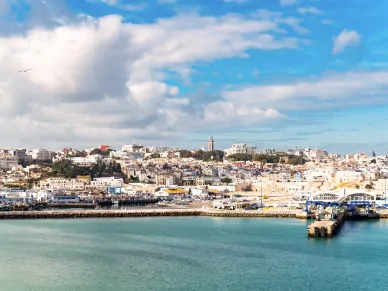
Tangier, Morocco
Tangier is a conjunction of Bohemian vibes and European cleanness compared to other Moroccan cities, which are quite dirty and noisy.
The distinctive European features stem from the French, British, and Spanish colonizers that inhabited these territories between the 18th and 19th centuries. The artists, performers, and writers that once chose those places for their creativity have engrained the bohemian atmosphere.
Here, Henri Matisse painted his Moroccan Triptych, and Eugène Delacroix created an array of sketches that later became the basis for such paintings as Moroccan Sheikh Visits His Trunk, Moroccan Saddles His Horse, etc.
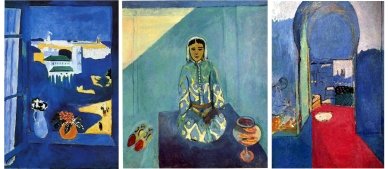
Henri Matisse's Moroccan Triptych
Tangier is a giant port of Africa and a perfect place for beach recreation nowadays. A fifty-kilometre line has stretched through the city and has comprised a myriad of luxurious beaches with excellent infrastructure and a European level of service.
Tangier actively develops and quickly changes its inimitable style. Nonetheless, there are still some must-see places that provide an opportunity to feel the atmosphere of the former shelter of artists, writers, and adventurers of all kinds.
Medina is an old part of the city that consists of narrow, winding streets. The ground floors of the houses, standing very close to each other, accommodate small souvenir shops, bakeries, and workshops. Modern progress has not touched those places, and since ages ago, all the products have been handmade. So wander around the medina and plunge into the atmosphere of the ancient oriental city, which makes you feel the magical Aladdin story.
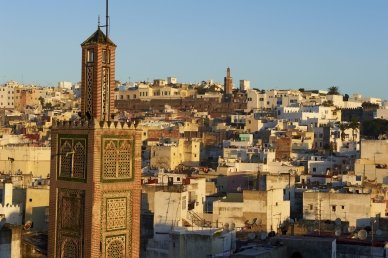
Medina, Tangier
When you have got out of the labyrinth of old streets, make for Dar al-Makhzen — the masterpiece of North African palace architecture built in the 17th century for Sultan Moulay Ismail Ibn Sharif. For many years, the palace was a residence for the monarch’s guests visiting Tangier.
In 1922, the snow-white building began to house two national museums of Morocco. Nowadays, the palace welcomes the guests who come to observe the impressive exhibitions in the halls of the Museum of Moroccan Arts and Antiquities. Here, attendees will see the famous carpets, luxurious jewelry, vases, different kinds of furniture made in Rabat. Those keen on antique history should explore the Carthaginian tomb and other antique art items.
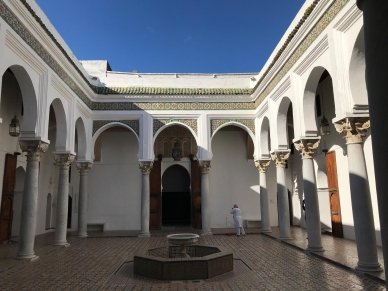
Dar al-Makhzen, Tangier
The other must-see destination for tourists is the Caves of Hercules, located in Cape Spartel, several kilometres from the city. The other cape that lures Tangier visitors is Malabata and the unique lighthouse. Its towers have magnificent views of the Atlantic Ocean, the Mediterranean Sea, and Gibraltar.
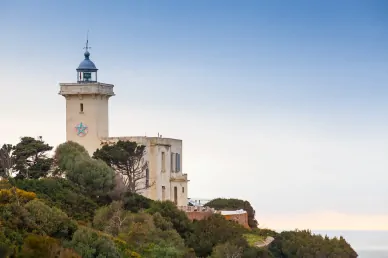
Lighthouse tower in Cap Malabata, Tangier, Morocco
Marrakesh
Legendary British Prime Minister Winston Churchill used to spend his vacation here. Marrakesh’s atmosphere was relaxing and inspiring at the same time. It sparked the politician’s creativity, something he could afford in his homeland so rarely.
In Marrakesh, Churchill painted exceptionally well: he drew numerous sketches of the Moroccan landscapes. He visited that place even during the times of World War II. Preoccupations with the fate of the Kingdom did not keep Winston Churchill from creating the Tower of the Koutoubia Mosque, his only big oil-on-canvas painting that he authored during the war period.

Winston Churchill's painting of Marrakech
The French fashion designer Yves Saint Laurent also found his source of inspiration in Marrakesh. Though neighbouring Algeria was his homeland, he could not imagine his life without the Moroccan sun and bright colours of that fantastic country. Yves would come there every year in June and December to create designs for his future collections.
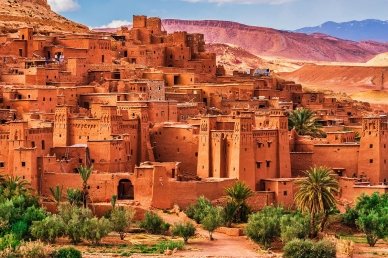
Marrakesh, Morocco
Start your acquaintance with Marrakesh in medina, the old part. It is usually called the Red City due to the peculiar red sandstone house walls. Actually, the uniform colour scheme is a distinctive feature of Moroccan architecture. The building facades in urban areas are commonly painted in one approved colour. For example, Tangier is white and blue, and Chefchaouen combines dark and light blue.
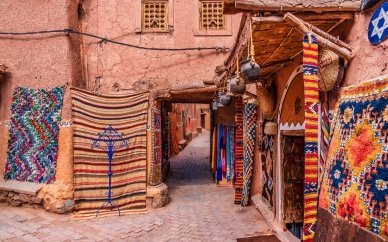
Carpets in the Medina, Marrakech
If you want to feel the charms of Marrakesh to the full extent, be sure to check out Jemaa el-Fnaa, the square in the very centre of the medina. Every evening, a magical performance resembling One Thousand and One Nights fairy tales is delivered.

Jemaa el-Fnaa, Marrakesh
Merchants, illusionists, dancers, singers, and jugglers gather at Jemaa el-Fnaa at dust. Amidst the oriental market in all its beauty, people sell their goods, sing, conjure snakes, tell fortunes, and even remove teeth.
Tip: before embarking on a tour to Morocco, visit a dentist. If you have some problems with teeth, undergo full treatment. It is not about the aching tooth that may spoil a vacation. In this country, dentists are too scarce: one orthodontist per 25,000 Moroccans.
Local people take some drastic measures. They do not receive any treatment but have a sore tooth out without anaesthetic, right on the market with the help of pliers. Jemaa el-Fnaa square is the so-called open-air “dentistry” for the courageous.
Medina is the spot of the Koutoubia, painted by Sir Winston Churchill on his canvas, and the Ben Youssef Mosque, one of the oldest in Morocco.
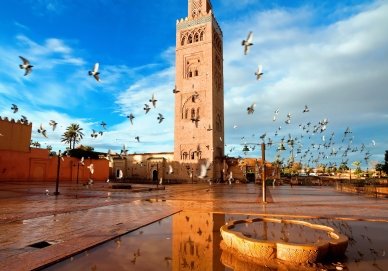
Koutoubia, Marrakesh
The Majorelle Garden is the other fabulous place in Marrakesh. The city itself is famous for its luxurious park area, but this creation of the French orientalist artist is a unique phenomenon.
The garden emerged in 1923 around the atelier villa of the master. Trees, shrubs, and flowers were brought from all continents to be grown in that stunning place. At present, more than 500,000 tourists arrive annually to explore the incredible whirlpool of colours.
The Majorelle’s villa houses the Museums of Islamic and Berber Arts and the gallery of the artist’s works.
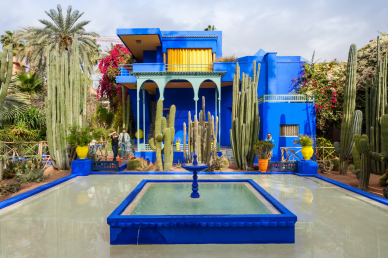
Majorelle Garden
Casablanca
In Spanish, the name of the biggest Moroccan city means white house. Its history and attractions are directly linked to the periods of reign of Portuguese and French colonizers.
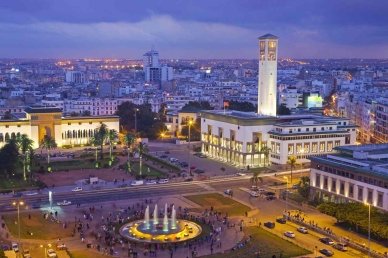
Casablanca, Morocco
Only the old city, medina, has retained the bright features of a typically Arab settlement, which consists of confusing labyrinths of streets, souvenir stores, and workshops.
Traditionally, a guided tour of Casablanca begins with Hassan II Mosque, the 210-metre minaret of which is considered the highest in the world. This unique creation of the French architect Michel Pinseau is located right on the coast of the Atlantic Ocean.
A large glass hall can accommodate 25,000 faithful Muslims for a simultaneous prayer. The square, which surrounds the mosque, is an extensive area for 80,000 worshippers.
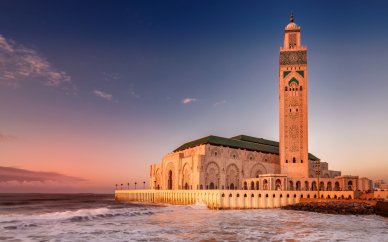
Hassan II Mosque, Casablanca, Morocco
Quartier Habous is the next sightseeing attraction of Casablanca. Local people call it a new medina for a range of souvenir stores and workshops, resembling the ancient Orient.
In fact, it is an affluent and new part of the city. The first villas were built there in the 1930s by well-off French colonizers. They enriched the urban architecture with the European features that make Casablanca look like a typical French city.
A walk around Habous brings much aesthetic pleasure, even though many people consider this neighbourhood an ordinary mix of the Arab and European styles. The most remarkable places of interest are Moulay Yousef and Mohammad V mosques, Mahkama du Pacha courthouse, and Olive Souk.

Mahkama du Pacha courthouse, Quartier Habous, Casablanca
If you want to try something unusual and sinister, go to Sidi Abderrahmane island. The popularity of this place is quite ominous as, according to the legends, there used to live only magicians, fortune-tellers, and seers — the acolytes of dark forces.
Nowadays, things are much simpler: this place has become occupied by ordinary people dealing with the fishery. The island’s atmosphere is perfect for solitude and reflection, nurtured by pristine and intact nature.
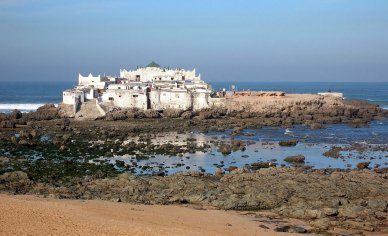
Sidi Abderrahmane island, Morocco
Food
Moroccans are avid fans of homemade food and eat out very rarely. Family meals often include several courses, among which couscous and tajin are of considerable importance.
Couscous constitutes small light-yellow granules that resemble micro pasta made of a particular sort of wheat flour.
Couscous is perfect for cooking porridge, soups, salads, stuffed lamb, and other dishes. It is so much popular that the Moroccans call it just the food. If they say that they have a lot of food, everyone will understand what is meant. Couscous is the staff of life.
One of the most common dishes is seven vegetables, a peculiar variation of couscous ragout with carrots, zucchini, cabbage, potatoes, sweet pepper, onions, and turnip. The combination of vegetables can vary, but the most important is the number — seven.

Moroccan Couscous With Meat and Seven Vegetables
The second most valuable dish of Moroccan cuisine is tajin. As a rule, it is meat or fish stewed with vegetables in a peculiar ceramic pot covered by a cone-shaped lid. Chinese cuisine also has a similar dish with a similar name.
Mutton, beef, lamb, chicken, or fish is usually simmered for a couple of hours together with potatoes, carrots, and other vegetables to get a juicy and flavourous ragout at the end.
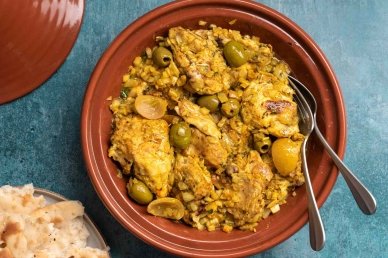
Moroccan Chicken Tajin with Olives and Preserved Lemons
The third position is taken by Bastilla, another Moroccan dish worth tasting. If you have never eaten the layered chicken pie with powdered sugar, try this meal, which is indispensable at any family celebration.
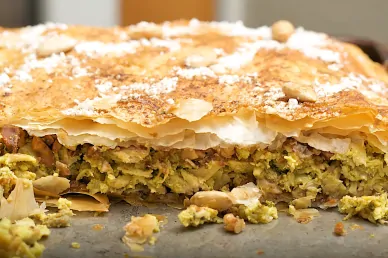
Moroccan Chicken Bastilla
In Morocco, they use the thin layered dough for baking it with pieces of meat, eggs, and onions. The dishes are then dusted with ground almonds, sprinkled with lemon juice, and covered with a layer of powdered sugar.
Frequently, they serve meat dishes with the addition of preserved lemons — sliced or chopped fruit that had turned sour in a special brine. Fermented lemons are not a typically Moroccan snack; they are common in North Africa, the Middle East (Algeria, Tunisia, Israel), India, and Cambodia.
The number one drink in Morocco is not coffee at all. Moroccans do like it, but most of all, they prefer a sweet and strong mint tea called Berber whiskey.
They drink it every day without any particular reasons. It is necessary to take a handful of dried mint, put it into a teapot, add much sugar, and make the tea.
Pour it into small glass cups at a one-metre height. Such a cascading is needed to obtain tea foam: the larger the foam, the tastier the tea.
Small glass cups are the only suitable items to delight the drink to the fullest. Only those who have got used to consuming Berber whiskey for many years can bear such a strong menthol taste and a syrup sweetness.
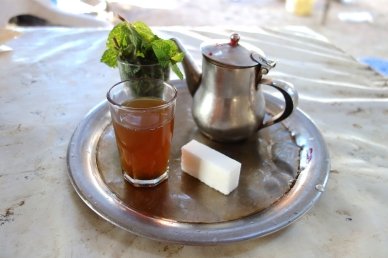
Moroccan strong mint tea called Berber whiskey
Morocco is a wonderful world of ancient traditions and modern trends. It is a country of fairy tales and sometimes shocking reality, a peculiar lifestyle and mentality. Do not speak much about it, but come here to see everything at first hand.
FAQ
How big is Morocco?
Morocco covers an area of about 446,550 square kilometers.
Is Morocco an African or Arab?
Morocco is both African and Arab. It is located in North Africa and is part of the Arab world culturally and linguistically.
What is the capital of Morocco?
The capital of Morocco is Rabat.
What are the main cities of Morocco?
Major cities in Morocco include Casablanca, Marrakech, Fes, Tangier, and Agadir.
What is Morocco's population?
Morocco's population is approximately 38 million people.
What language is mostly spoken in Morocco?
Arabic is the official language, and Berber (Amazigh) languages are also widely spoken. French is used extensively in business and education.
What is the most common religion in Morocco?
The most common religion in Morocco is Islam.
What is Moroccan currency?
The currency of Morocco is the Moroccan Dirham (MAD).
Is Morocco a rich or poor country?
Morocco is considered a developing country with a growing economy, but it still faces challenges in poverty and inequality.
What type of government is Morocco under?
Morocco is a constitutional monarchy with an elected parliament. The King of Morocco holds significant executive and legislative powers.
What is Morocco famous for?
Morocco is famous for its rich culture and history, beautiful landscapes, historic cities, vibrant souks (markets), and diverse architecture, including Moorish, Berber, and French colonial styles.
What is the best month to go to Morocco?
The best months to visit Morocco are during the spring (April to May) and fall (September to October) when the weather is more comfortable.
Do you need a visa to go to Morocco?
Visa requirements for Morocco depend on your nationality. Many countries can enter Morocco for short stays without a visa.
Is it safe to go to Morocco right now?
Generally, Morocco is considered safe for tourists, but visitors should remain aware of their surroundings and take standard safety precautions.
Is Morocco a friendly country to visit?
Morocco is known for its hospitable people and rich cultural experiences, making it a friendly and popular destination for tourists.







